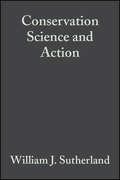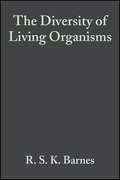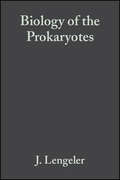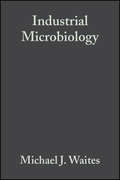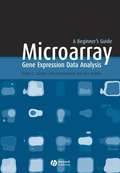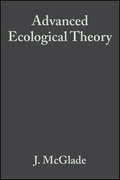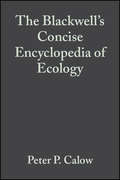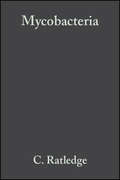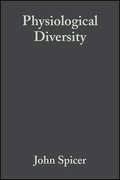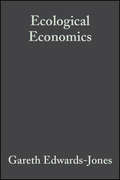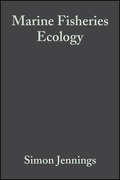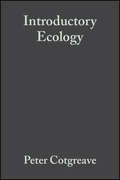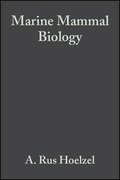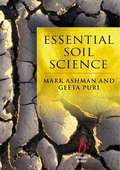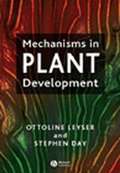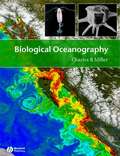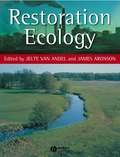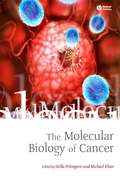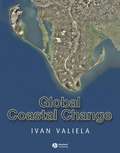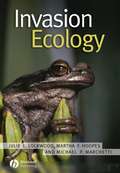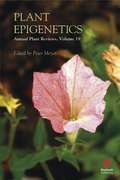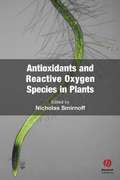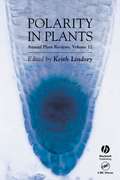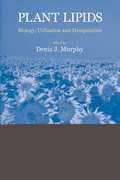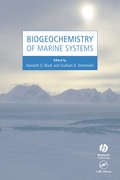- Table View
- List View
Conservation Science and Action
by William J. SutherlandConservation Science and Action is intended for upper-level undergraduate and graduate courses in conservation biology. This book reviews the latest thinking and approaches, and in doing so provides a readily accessible reference work for conservation professionals and managers. Because conservation biology is now one of the most dynamic disciplines in the life sciences, William Sutherland and his international team of authors have selected many of the liveliest topics where key advances are currently being made. They stress ideas, point to unresolved issues, and suggest possible future developments. Finally, since conservation is an applied subject, the book's emphasis throughout is on action. Essential reading for senior undergraduate and postgraduate students taking courses in conservation biology, one of the most dynamic disciplines in the life sciences. Contributions from leading figures in the field who have selected the liveliest topics where key advances are being made. Reviews the latest thinking and approaches. Contributors cover a range of taxonomic groups, include aquatic and terrestrial plants and animals, and give examples from around the world. Emphasis given to action, and all chapters have an applied component.
The Diversity of Living Organisms
by R. S. K. BarnesSuch is the pressure on teaching time in schools and universities that students are taught less and less of the diversity that is life on this planet. Most students, and indeed most professional biologists that these students become, know far more of cell function than of biodiversity. This text is a profusely illustrated, quick-reference guide to all types of living organisms, from the single-celled prokaryotes and eurkaryotes to the multicellular fungi, plants and animals. All surviving phyla and their component classes are characterised and described, as are their lifestyles, ecology, relationships, and within-group diversity (with orders displayed in list form). Overall, the book's aim is to provide biologists and others with a clear, concise picture of the nature of all groups of organisms with which they may be unfamiliar.
Biology of the Prokaryotes
by Hans G. Schlegel Joseph W. Lengeler Gerhart DrewsDesigned as an upper-level textbook and a reference for researchers, this important book concentrates on central concepts of the bacterial lifestyle. Taking a refreshingly new approach, it present an integrated view of the prokaryotic cell as an organism and as a member of an interacting population. Beginning with a description of cellular structures, the text proceeds through metabolic pathways and metabolic reactions to the genes and regulatory mechanisms. At a higher level of complexity, a discussion of cell differentiation processes is followed by a description of the diversity of prokaryotes and their role in the biosphere. A closing section deals with man and microbes (ie, applied microbiology). The first text to adopt an integrated view of the prokaryotic cell as an organism and as a member of a population. Vividly illustrates the diversity of the prokaryotic world - nearly all the metabolic diversity in living organisms is found in microbes. New developments in applied microbiology highlighted. Extensive linking between related topics allows easy navigation through the book. Essential definitions and conclusions highlighted. Supplementary information in boxes.
Industrial Microbiology: An Introduction
by Michael J. Waites Neil L. Morgan John S. Rockey Gary HigtonOf major economic, environmental and social importance, industrial microbiology involves the utilization of microorganisms in the production of a wide range of products, including enzymes, foods, beverages, chemical feedstocks, fuels and pharmaceuticals, and clean technologies employed for waste treatment and pollution control. Aimed at undergraduates studying the applied aspects of biology, particularly those on biotechnology and microbiology courses and students of food science and biochemical engineering, this text provides a wide-ranging introduction to the field of industrial microbiology. The content is divided into three sections: key aspects of microbial physiology, exploring the versatility of microorganisms, their diverse metabolic activities and products industrial microorganisms and the technology required for large-scale cultivation and isolation of fermentation products investigation of a wide range of established and novel industrial fermentation processes and products Written by experienced lecturers with industrial backgrounds, Industrial Microbiology provides the reader with groundwork in both the fundamental principles of microbial biology and the various traditional and novel applications of microorganisms to industrial processes, many of which have been made possible or enhanced by recent developments in genetic engineering technology. A wide-ranging introduction to the field of industrial microbiology Based on years of teaching experience by experienced lecturers with industrial backgrounds Explains the underlying microbiology as well as the industrial application. Content is divided into three sections: 1. key aspects of microbial physiology, exploring the versatility of microorganisms, their diverse metabolic activities and products 2. industrial microorganisms and the technology required for large-scale cultivation and isolation of fermentation products 3. investigation of a wide range of established and novel industrial fermentation processes and products
Microarray Gene Expression Data Analysis: A Beginner's Guide
by Helen Causton John Quackenbush Alvis BrazmaThis guide covers aspects of designing microarray experiments and analysing the data generated, including information on some of the tools that are available from non-commercial sources. Concepts and principles underpinning gene expression analysis are emphasised and wherever possible, the mathematics has been simplified. The guide is intended for use by graduates and researchers in bioinformatics and the life sciences and is also suitable for statisticians who are interested in the approaches currently used to study gene expression. Microarrays are an automated way of carrying out thousands of experiments at once, and allows scientists to obtain huge amounts of information very quickly Short, concise text on this difficult topic area Clear illustrations throughout Written by well-known teachers in the subject Provides insight into how to analyse the data produced from microarrays
Advanced Ecological Theory: Principles and Applications
by J. McGladeAdvanced Ecological Theory is intended for both postgraduate students and professional researchers in ecology. It provides an overview of current advances in the field as well as closely related areas in evolution, ecological economics, and natural-resource management, familiarizing the reader with the mathematical, computational and statistical approaches used in these different areas. The book has an exciting set of diverse contributions written by leading authorities.
Blackwell's Concise Encyclopedia of Ecology
by Peter P. CalowThe language of ecology has grown rapidly and changed extensively over the last decade. From Arrhenotoky to Psammosere; from the One-tailed test to Zoocoenosis, the Blackwell Concise Encyclopedia of Ecology provides concise, non-technical definitions of over 2000 ecological terms, covering the complete spectrum of pure and applied ecological research. The definitions are drawn from the Encyclopedia of Ecology and Environmental Management, and are fully cross-referenced. This is the most comprehensive and up-to-date dictionary of ecological terms available. It should be invaluable to students and researchers alike. Over 2000 terms defined Avoids technical jargon Fully cross-referenced Includes common abbreviations
Mycobacteria: Molecular Biology and Virulence
by C. Ratledge J. W. DaleTuberculosis continues to kills more people than any other single infective agent. The resurgence of the disease in many countries has produced a heightened awareness of the threat posed by mycobacterial infections. At the same time, there has been an explosion of knowledge of the fundamental properties of mycobacteria, most notably the determination of the complete genome sequence of Mycobacterium tuberculosis. This book provides an up-to-date account of these developments in the molecular biology and immunology of mycobacteria, coupled with allied advances of a more applied nature, such as the use of molecular techniques for diagnosis and epidemiological investigations. With chapters contributed from an international team of experts, it will not only be an essential reference text for the expanding mycobacterial research community, but also will find a prominent place on the shelves of clinicians, infectious disease and public health specialists, diagnostic laboratories, postgraduate students and indeed anyone concerned with the management and investigation of outbreaks of tuberculosis. Comprehensively covers recent advances in the molecular biology of the mycobacteria. First book to be published on this subject since the publishing of the complete genome for the tubercle bacillus (M. tuberculosis). Coincides with a worldwide resurgence of tuberculosis.
Physiological Diversity: Ecological Implications
by John Spicer Kevin GastonEcologists have always believed, at least to a certain extent, that physiological mechanisms serve to underpin ecological patterns. However, their importance has traditionally been at best underestimated and at worst ignored, with physiological variation being dismissed as either an irrelevance or as random noise/error. Spicer and Gaston make a convincing argument that the precise physiology does matter! In contrast to previous works which have attempted to integrate ecology and physiology, Physiological Diversity adopts a completely different and more controversial approach in tackling the physiology first before moving on to consider the implications for ecology. This is timely given the recent and considerable interest in the mechanisms underlying ecological patterns. Indeed, many of these mechanisms are physiological. This textbook provides a contemporary summary of physiological diversity as it occurs at different hierarchical levels (individual, population, species etc.), and the implications of such diversity for ecology and, by implication, evolution. It reviews what is known of physiological diversity and in doing so exposes the reader to all the key works in the field. It also portrays many of these studies in a completely new light, thereby serving as an agenda for, and impetus to, the future study of physiological variation. Physiological Diversity will be of relevance to senior undergraduates, postgraduates and professional researchers in the fields of ecology, ecological physiology, ecotoxicology, environmental biology and conservation. The book spans both terrestrial and marine systems.
Ecological Economics: An Introduction
by Gareth Edwards-Jones Ben Davies Salman S. HussainEcological economics is an exciting interdisciplinary field of study that combines insights from the natural sciences, economics, philosophy and other fields to develop innovative approaches to environmental problems. It draws on a wide range of analytical perspectives, some radical others more conventional, to build a more complete understanding of human-ecosystem interactions. Current research in the field includes work on nature conservation, land use planning, pollution control, natural resource management, and environmental impact assessment/evaluation. Ecological Economics provides a comprehensive introduction to the core themes, presented in a clearly structured style, with chapters tailored specifically to readers without any economic or philosophical training. There is an emphasis throughout on the complementary roles of economics, ethics and ecology in environmental decision-making processes. The book reviews the evolution of important ideas in the field, explores the fundamental philosophies underlying different approaches to environmental problems, explains in detail the specific tools and techniques used in these approaches, and gives numerous examples of how they can be applied. Special importance is attached to understanding both the advantages and limitations of different analyses, in order to provide a balanced and coherent view of how these different approaches interrelate and how their roles vary in different contexts. Written by three authors specializing in ecology, economics and philosophy, this textbook provides an excellent introduction to the field of ecological economics for students in the natural sciences and other environmental disciplines. It will also be of interest to a wide range of professionals and researchers involved in environmental management and policy, and thers including economists seeking to broaden their knowledge of new methodologies and approaches. Further reading suggestions and extensive references are provided for those interested in pursuing particular themes beyond the introductory level. The first introductory ecological economics text written specifically for natural scientists. Assumes no prior knowledge of economics or philosophy. Emphasises the complementary roles of ecology, economics and ethics in environmental decision-making processes. An emphasis on clarity and accessibility throughout.
Marine Fisheries Ecology
by Simon Jennings Michel Kaiser John D. ReynoldsThis topical and exciting textbook describes fisheries exploitation, biology, conservation and management, and reflects many recent and important changes in fisheries science. These include growing concerns about the environmental impacts of fisheries, the role of ecological interactions in determining population dynamics, and the incorporation of uncertainty and precautionary principles into management advice. The book draws upon examples from tropical, temperate and polar environments, and provides readers with a broad understanding of the biological, economic and social aspects of fisheries ecology and the interplay between them. As well as covering 'classical' fisheries science, the book focuses on contemporary issues such as industrial fishing, poverty and conflict in fishing communities, marine reserves, the effects of fishing on coral reefs and by-catches of mammals, seabirds and reptiles. The book is primarily written for students of fisheries science and marine ecology, but should also appeal to practicing fisheries scientists and those interested in conservation and the impacts of humans on the marine environment. particularly useful are the modelling chapters which explain the difficult maths involved in a user-friendly manner describes fisheries exploitation, conservation and management in tropical, temperate and polar environments broad coverage of 'clasical' fisheries science emphasis on new approaches to fisheries science and the ecosystem effects of fishing examples based on the latest research and drawn from authors' international experience comprehensively referenced throughout extensively illustrated with photographs and line drawings
Introductory Ecology
by Peter Cotgreave Irwin ForsethIn this age of increasing human domination of the Earth's biological and physical resources, a basic understanding of ecology is more important than ever. Students need a textbook that introduces them to the basic principles of ecological science, one that is relevant to today's world, and one that does not overwhelm them with detail and jargon. Peter Cotgreave and Irwin Forseth have designed this book to meet the needs of these students, by providing a basic synthesis of how individual organisms interact with their physical environment, and with each other, to generate the complex ecosystems we see around us. The unifying theme of the book is biodiversity-its patterns, causes, and the growing worldwide threats to it. Basic ecological principles are illustrated using clearly described examples from the current ecological literature. This approach makes the book valuable to all students studying ecology. Examples have been chosen carefully to represent as wide a range of ecosystems (terrestrial and aquatic, northern and southern hemisphere) and life forms (animal, plant and microbe) as possible. Particular attention is paid to consequences of global change on organisms, populations, ecological communities and ecosystems. The end result is a text that presents a readable and persuasive picture of how the Earth's natural systems function, and how that functioning may change over the coming century. Features include: · strong coverage of applied and evolutionary ecology · applications of ecology to the real world · a question-orientated approach · the only comprehensive treatment of ecology written for the introductory student · an emphasis on definitions of key words and phrases · an integration of experimental, observational and theoretical material · examples drawn from all over the world and a wide variety of organisms · a logical structure, building from the response of individual organisms to physical factors, through population growth and population interactions, to community structure and ecosystem function · suggested further reading lists for each chapter · boxes to explain key concepts in more depth · dedicated textsite featuring additional information and teaching aids www.blackwellpublishing.com/cotgreave Peter Cotgreave is an animal ecologist who has worked for the University of Oxford and the Zoological Society of London. His research interests centre on abundance and rarity within animal communities. Irwin Forseth is a plant physiological ecologist who has taught introductory ecology and plant ecology at the University of Maryland since 1982. His research focuses on plant responses to the environment. The authors have studied organisms as diverse as green plants, insects and mammals in habitats from deserts to tropical rainforests. They have worked in ecological research and education in Africa, Asia, North and South America, Europe and the Caribbean.
Marine Mammal Biology: An Evolutionary Approach
by A. Rus HoelzelThis book provides a general introduction to the biology of marine mammals, and an overview of the adaptations that have permitted mammals to succeed in the marine environment. Each chapter, written by experts in their field, will provide an up-to-date review and present the major discoveries and innovations in the field. Important technical advances such as satellite telemetry and time-depth-recorders will be described in boxes.
Essential Soil Science: A Clear and Concise Introduction to Soil Science
by Mark Ashman Geeta PuriThis textbook is aimed at the majority of students, who need to quickly acquire a concise overview of soil science. Many current soil science textbooks still cater for a traditional student market where students embark on three years study in a narrow discipline. The growth in modular degree schemes has meant that soil science is now often taught as self-standing unit as part of broad based degree program. Students pursuing this type of course are increasingly reluctant to purchase expensive textbooks that are too detailed and often assume a scientific background. For those opting to specialise in soil science there are a variety of good textbooks to choose from. This short informative guide, will be particularly useful for students who do not possess a traditional scientific background, such as those studying geography, environment science, ecology and agriculture. Only textbook to cater for introductory courses in soil science. Provides an affordable concise overview of soil science. Learning exercises and chapter summaries enhance usability. Annotated suggestions for further reading. Based on proven and successful modular course structure. Emphasis on readability and interactive learning. No scientific background assumed.
Mechanisms in Plant Development
by Ottoline Leyser Stephen DayIntended for undergraduate and graduate courses in plant development, this book explains how the cells of a plant acquire and maintain their specific fates. Plant development is a continuous process occurring throughout the life cycle, with similar regulatory mechanisms acting at different stages and in different parts of the plant. Rather than focussing on the life cycle, the book is structured around these underlying mechanisms, using case studies to provide students with a framework to understand the many factors, both environmental and endogenous, that combine to regulate development and generate the enormous diversity of plant forms. New approach to the study of plant development and a refreshing look at this fast-moving area. Authors focus their discussion on the basic mechanisms which underpin plant development, tackling the fundamental question of how a single cell becomes a complex flowering plant from a cellular perspective. An up-to-date, modern text in plant development for advanced level undergraduates and postgraduates in plant science. Thought-provoking treatment of a difficult subject, the text will satisfy the needs of advanced level undergraduates and postgraduates in plant science. Experimental case studies throughout. The artwork from the book is available at www.blackwellpublishing.com/leyser
Biological Oceanography
by Charles B. MillerThis modern textbook of biological oceanography is aimed at students taking oceanography, marine biology and marine sciences courses. It covers recent developments such as the molecular techniques (including sequence data) that have allowed a re-examination of the ocean's microbial ecology and the role of the various trophic groups in biogeochemical cycling, carbon flow and climate control. Major topics covered include phytoplankton bloom, microbial food web, marine biogeography, global climate change and an overview of fisheries oceanography. Difficult concepts are explained in a straightforward manner, making this book accessible to undergraduates, graduates and researchers alike. Features a chapter on important numerical models which have become indispensable in biological oceanography. Further details of key terms and important topics are highlighted in boxes Models, formulas, methodologies, and techniques are described and explained throughout. An Instructor manual CD-ROM for this title is available. Please contact our Higher Education team at HigherEducation@wiley.com for more information.
Restoration Ecology: The New Frontier
by James Aronson Jelte Van AndelAimed at Masters, and PhD students, teachers, researchers and natural resource managers, this book explores the interface between restoration ecology and ecological restoration. Covers both the ecological concepts involved in restoration ecology and their practical applications. Written by an excellent group of ecologists from centres across Europe with a strong reputation for restoration ecology. Only textbook around aimed specifically at advanced undergraduate courses and postgraduate study programmes.
The Molecular Biology of Cancer
by Stella Pelengaris Michael KhanThis comprehensive text provides a detailed overview of the molecular mechanisms underpinning the development of cancer and its treatment. Written by an international panel of researchers, specialists and practitioners in the field, the text discusses all aspects of cancer biology from the causes, development and diagnosis through to the treatment of cancer. Written by an international panel of researchers, specialists and practitioners in the field Covers both traditional areas of study and areas of controversy and emerging importance, highlighting future directions for research Features up-to-date coverage of recent studies and discoveries, as well as a solid grounding in the key concepts in the field Each chapter includes key points, chapter summaries, text boxes, and topical references for added comprehension and review Supported by a dedicated website at www.blackwellpublishing.com/pelengaris An excellent text for upper-level courses in the biology of cancer, for medical students and qualified practitioners preparing for higher exams, and for researchers and teachers in the field
Global Coastal Change
by Ivan ValielaGlobal Coastal Changeprovides a comprehensive overview of the environmental factors changing the marine systems of the world including atmospheric changes, sea level rise, alterations in freshwater and sediment use and transport, toxins, overfishing, alien species, and eutrophication. Includes case studies providing real-world examples, detailed reviews of the evidence of changes and possible solutions. Brings together a wealth of important information about our changing marine environments. An invaluable reference for upper level undergraduates, graduates, and professionals interested in marine environmental science.
Invasion Ecology
by Julie L. Lockwood Martha F. Hoopes Michael P. MarchettiThis book provides a comprehensive introduction to all aspects of biological invasion by non-native species. Highlighting important research findings associated with each stage of invasion, Invasion Ecology provides an overview of the invasion process from transportation patterns and causes of establishment success to ecological impacts, invader management, and post-invasion evolution. Increasing awareness of the problems associated with invasion has led to a rapid growth in research into the dynamics of non-native species and their adverse effects on native biota and human economies. This book provides a synthesis of this fast growing field of research, and is an essential text for undergraduate and graduate students in ecology and conservation management.
Annual Plant Reviews, Plant Epigenetics (Annual Plant Reviews)
by Peter MeyerWith the discovery of RNAi pathways and the histone code, epigenetics has become a popular and fast evolving research topic. Plant science has made a number of elementary contributions to this field, and the common elements of epigenetic systems have linked research groups interested in plant, fungal and animal systems. This volume provides a comprehensive overview epigenetic mechanisms and biological processes in plants, illustrating the wider relevance of this research to work in other plant science areas and on non-plant systems. It discusses recent advances in our knowledge of basic mechanisms and molecular components that control transcriptional and post-transcriptional silencing, an understanding of which is essential for plant researchers who use transgenic lines for stable expression of a recombinant construct or for targeted inactivation of an endogenous gene. These aspects should be of special interest to the agricultural industry. The volume illustrates the relevance of epigenetic control systems to gene regulation and plant development, examining paramutation, genomic imprinting and microRNA-based gene regulation mechanisms. Finally, it demonstrates the significance of epigenetic systems to viral defence and genome organisation. The volume is directed at researchers and professionals in plant molecular genetics, plant biochemistry and plant developmental biology.
Antioxidants and Reactive Oxygen Species in Plants (Biological Sciences Series)
by Nicholas SmirnoffReactive oxygen species (ROS) are produced during the interaction of metabolism with oxygen. As ROS have the potential to cause oxidative damage by reacting with biomolecules, research on ROS has concentrated on the oxidative damage that results from exposure to environmental stresses and on the role of ROS in defence against pathogens. However, more recently, it has become apparent that ROS also have important roles as signalling molecules. A complex network of enzymatic and small molecule antioxidants controls the concentration of ROS and repairs oxidative damage, and research is revealing the complex and subtle interplay between ROS and antioxidants in controlling plant growth, development and response to the environment. This book covers these new developments, generally focussing on molecular and biochemical details and providing a point of entry to the detailed literature. It is directed at researchers and professionals in plant molecular biology, biochemistry and cell biology, in both the academic and industrial sectors.
Annual Plant Reviews, Polarity in Plants (Annual Plant Reviews #56)
by Keith LindseyAnnual Plant Reviews, Volume 12 A fundamental feature of developmental biology is that of the establishment of polarity. It can be described at different levels - polarity of the organism, polarity in tissue patterning and organ development, and polarity of the cell. This volume provides an account of current research into the mechanisms by which polarity is generated at the level of the cell, organ and organism in plants, drawing especially on recent work with model organisms.The emphasis is on the use of the techniques of molecular genetics to dissect molecular mechanisms. This is the first volume to bring together the diverse aspects of polarity in plant development. It is directed at researchers and professionals in plant developmental biology, cell biology and molecular biology. Visit www.blackwellplantsci.com the plant science site from Blackwell Publishing.
Plant Lipids: Biology, Utilisation and Manipulation (Biological Sciences Series)
by Denis J. MurphyNew research tools have revealed many surprising aspects of the dynamic nature of lipids and their participation in processes such as recognition, intra- and inter-cellular signalling, deterrence and defence against pathogens, membrane trafficking and protein function. This is in addition to new information on the more established roles of plant lipids as structural components of membranes and as long-term storage products. Plant lipids are also increasingly being seen as sources of a new generation of environmentally friendly, biodegradable and renewable industrial products, including biopolymers and high grade lubricants. This volume provides a broad overview of plant lipid research and its many applications, linking the various disciplines and providing an interesting and wide-ranging perspective on this fast-moving field. Extensive lists of references are provided, totalling well over two thousand non-redundant citations and offering a point of entry to the detailed literature. This is a book for researchers and professionals in plant biochemistry, molecular biology, biotechnology and genetics, in both the academic and industrial sectors.
Biogeochemistry of Marine Systems (Biological Sciences Series)
by Kenneth D. Black Graham B. ShimmieldMarine systems vary in their sensitivities to perturbation. Perturbation may be insidious – such as increasing eutrophication of coastal areas – or it may be dramatic – such as a response to an oil spillage or some other accident. Climate change may occur incrementally or it may be abrupt, and ecosystem resilience is likely to be a complex function of the interactions of those assemblages or species mediating key biogeochemical processes. Biogeochemistry of Marine Systems considers issues of marine system resilience, focusing on a range of marine systems that exemplify major global province types but are also interesting and topical in their own right, on account of their sensitivity to natural or anthropogenic change or their importance as ecological service providers. Authors concentrate on advances of the last decade.
